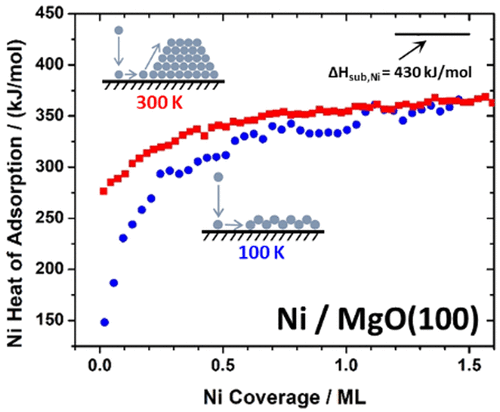当前位置:
X-MOL 学术
›
J. Phys. Chem. C
›
论文详情
Our official English website, www.x-mol.net, welcomes your feedback! (Note: you will need to create a separate account there.)
Energetics and Structure of Nickel Atoms and Nanoparticles on MgO(100)
The Journal of Physical Chemistry C ( IF 3.7 ) Pub Date : 2020-06-12 , DOI: 10.1021/acs.jpcc.0c03468 Zhongtian Mao 1 , Wei Zhao 1 , Ziareena A. Al-Mualem 1 , Charles T. Campbell 1
The Journal of Physical Chemistry C ( IF 3.7 ) Pub Date : 2020-06-12 , DOI: 10.1021/acs.jpcc.0c03468 Zhongtian Mao 1 , Wei Zhao 1 , Ziareena A. Al-Mualem 1 , Charles T. Campbell 1
Affiliation

|
The growth morphology and interfacial energetics of vapor-deposited Ni on the MgO(100) surface at 300 and 100 K have been studied using single crystal adsorption calorimetry (SCAC), He+ low-energy ion scattering spectroscopy (LEIS), X-ray photoelectron spectroscopy (XPS), and low-energy electron diffraction (LEED). At 300 K, the Ni atoms grow as three-dimensional nanoparticles with a saturation number density of 5 × 1016 particles/m2. The differential heat of adsorption at 300 K increases rapidly with coverage, from 276 (initially) to 335 kJ/mol by 0.4 ML. Thereafter, it slowly increases asymptotically to the sublimation enthalpy of bulk Ni (430 kJ/ml) by 9 ML. The Ni 2p3/2 XPS peak binding energy at 300 K is initially (i.e., at 0.16 ML) 1.4 eV higher than that for bulk Ni(solid), but it decreases to that value at high coverage. The Ni atoms form a metastable hcp phase at 300 K when in nanoparticles with diameter <2.5 nm, and the adhesion energy of such Ni nanoparticles to MgO(100) was found to be 3.05 J/m2. At 100 K, the Ni atoms form single adatoms and then 0.17 nm thick 2D islands at low coverage with fewer Ni–Ni bonds compared to the Ni nanoparticles formed at 300 K. Thus, the initial heat (i.e., for the first ∼0.03 ML) is 148 kJ/mol at 100 K, 128 kJ/mol lower than that at 300 K, and remains lower for the 2D islands. With increasing coverage at 100 K, the tiny 2D Ni islands grow in size to cover nearly the entire surface before thickening. The XPS Ni 2p3/2 peak binding energy for 0.21 ML Ni on MgO(100) at 100 K is 2.2 eV higher than that for bulk Ni(solid), suggesting charge transfer from Ni to MgO(100) and formation of Ni2+ at very low coverage.
中文翻译:

MgO(100)上镍原子和纳米粒子的能级和结构
使用单晶吸附量热法(SCAC),He +低能离子散射光谱(LEIS),X射线研究了MgO(100)在300和100 K时气相沉积Ni在MgO(100)表面的生长形态和界面能光电子能谱(XPS)和低能电子衍射(LEED)。在300 K下,Ni原子以三维纳米粒子的形式生长,其饱和数密度为5×10 16粒子/ m 2。300 K时的吸附差热随覆盖范围迅速增加,从276(最初)到335 kJ / mol,增加了0.4 ML。此后,它逐渐渐近地增加到9毫升,升华到本体镍(430 kJ / ml)的升华焓。镍2p 3/2在300 K时,XPS的峰值结合能最初(即在0.16 ML时)比块状Ni(固体)的结合能高1.4 eV,但在高覆盖率时降低到该值。当在直径小于2.5 nm的纳米粒子中,Ni原子在300 K时形成亚稳态的hcp相,发现此类Ni纳米粒子对MgO(100)的粘附能为3.05 J / m 2。在300 K时形成的Ni纳米粒子,在100 K时,Ni原子形成单个原子,然后以低覆盖率形成0.17 nm厚的二维岛,具有较少的Ni–Ni键。因此,初始热(即,最初的0.03 ML )在100 K时为148 kJ / mol,比300 K时低128 kJ / mol,并且对于2D岛而言仍然较低。随着100 K覆盖率的增加,微小的2D Ni岛的尺寸逐渐变大,在增厚之前几乎覆盖了整个表面。XPS Ni 2p 3/2在100 K时MgO(100)上0.21 ML Ni的最大结合能比块状Ni(固体)高2.2 eV,表明电荷从Ni转移到MgO(100)并在极低覆盖率下形成Ni 2+。
更新日期:2020-07-09
中文翻译:

MgO(100)上镍原子和纳米粒子的能级和结构
使用单晶吸附量热法(SCAC),He +低能离子散射光谱(LEIS),X射线研究了MgO(100)在300和100 K时气相沉积Ni在MgO(100)表面的生长形态和界面能光电子能谱(XPS)和低能电子衍射(LEED)。在300 K下,Ni原子以三维纳米粒子的形式生长,其饱和数密度为5×10 16粒子/ m 2。300 K时的吸附差热随覆盖范围迅速增加,从276(最初)到335 kJ / mol,增加了0.4 ML。此后,它逐渐渐近地增加到9毫升,升华到本体镍(430 kJ / ml)的升华焓。镍2p 3/2在300 K时,XPS的峰值结合能最初(即在0.16 ML时)比块状Ni(固体)的结合能高1.4 eV,但在高覆盖率时降低到该值。当在直径小于2.5 nm的纳米粒子中,Ni原子在300 K时形成亚稳态的hcp相,发现此类Ni纳米粒子对MgO(100)的粘附能为3.05 J / m 2。在300 K时形成的Ni纳米粒子,在100 K时,Ni原子形成单个原子,然后以低覆盖率形成0.17 nm厚的二维岛,具有较少的Ni–Ni键。因此,初始热(即,最初的0.03 ML )在100 K时为148 kJ / mol,比300 K时低128 kJ / mol,并且对于2D岛而言仍然较低。随着100 K覆盖率的增加,微小的2D Ni岛的尺寸逐渐变大,在增厚之前几乎覆盖了整个表面。XPS Ni 2p 3/2在100 K时MgO(100)上0.21 ML Ni的最大结合能比块状Ni(固体)高2.2 eV,表明电荷从Ni转移到MgO(100)并在极低覆盖率下形成Ni 2+。


























 京公网安备 11010802027423号
京公网安备 11010802027423号